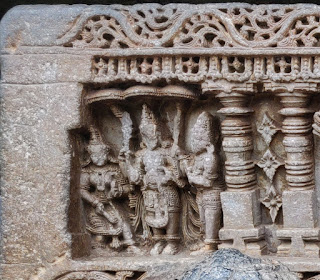The significance of the Ramayan and Shri Ram, in sustaining and strengthening the Hindu faith, in the face of innumerable onslaughts is, therefore, something that can never be undermined, as it is the binding glue that has shrugged off every form of religious expansionism by supposedly liberal, western forces. The spiritual fervour with which Hindus worship Shri Ram and imbibe his ethos is evident in many respects, especially so with regard to Prabhu Ram's adherence to dharma, whose journey in Ramayana teach us values and ethics . Rama means goodness and ayana means journey , Ramayana is the journey to goodness.
Here the complete Rāmāyaṇa story narrated on the kakṣāsana exterior wall in about 75 frames.
Viṣṇu creating brahmā; brahmā creates dakṣa sanaka sanaṅdanādi prajāpatis. This marks the beginning of trētāyuga.
Daṣaratha welcoming sage Vasiṣṭha along with his three wives Kausalyā, Sumitrā and Kaikādēvī.
Per sage Vasiṣṭha's advice, Daśaratha performs "putrakāmēṣṭi" yāga desiring for birth of a male child. Kausalyā Sumitrā and Kaikādēvī are also seen.
Remember - yāga won't yield any phala unless wife takes part in it.
Daśaratha seen with his four children - Rāma, Lakṣmaṇa, Bharata and Shatṛghna.
Sage Viśvāmitra in Daśaratha's court offering to teach his kids.
Rāma and Lakṣmaṇa following Sage Viśvāmitra.
Rāma fighting Tāṭakā - the female demon that disrupted Viśvāmitra's yajñas. Rāma kills the demoness.
Rāma fighting Subāhu, son of Tāṭaka. The other son of Tāṭaka - Mārīca appears later to take revenge for his mother and brother's killing at the request of his sister Kaikēśi's son Rāvaṇa.
Viśvāmitra takes Rāma-Lakṣmaṇa to Mithilā - Janaka Maharaja's court. Convinces Rāma to take part in Jānakī svayamvara.
Śiva dhanu bhaṅjana by Rāma. Elated Jānakī seen with a garland in her right hand.
Kaikādēvī asking for her three boons from Daśaratha, the ultimate boon seeking Rāma be sent on exile along with Sītā. Kaikādēvī's dāsī Maṅtharā is also seen. Daśaratha breaks down.
Rāma and Sītā embarking upon to 14 years of vanavāsa. Lakṣmaṇa tags along.
The trio meet Guha - the tribal leader who becomes a trusted friend of Rāma on the banks of Sarayū river.
Guha helps Rāma Sītā and Lakṣmaṇa to cross the river, and even directs them on their path. Guha's villagers are seen along.
Śūrpaṇakhā approaches Rāma. He diverts her to Lakṣmaṇa and Lakṣmaṇa chops off her nose.
Mārīca as a māyāmṛga appears and Sītā desires for it. (Refer 10/n)
Rāma chasing the māyāmṛga. Lakṣmaṇa following him at Sītā's request. Mārīca depicted at right corner.
Rāvaṇa asking Sītā for alms.
Rāvaṇa abducting Sītā in his Puṣpakavimāna. Jaṭāyu tries to stop him.
Rāvaṇa cuts off Jaṭāyu's wings.
Rāma-Lakṣmaṇa meet Sugrīva and Āṅjanēya while searching for Sītā.
In responding to Sugrīva's doubts, Rāma uses sarpāstra bestowed upon him by Maharṣi Viśvāmitra, chopping off 7 sāḷa vṛkṣas (palm trees) in a row, in one go. (ఒక మాట ఒక బాణము)
Vāli vadhā. Sugrīva takes on his brother Vāli. Rāma seen behind a tree, shoots an arrow and slays Vāli.
Sugrīva adorns the throne. Rāma-Lakṣmaṇa bless him. Other vānaras are seen celebrating the occasion with musical instruments.
Tārā - Vāli's wife, later Sugrīva's second wife thanking Rāma.
Sugrīva offering help on behalf of all vānaras in finding Sītā.
Rāmasētu construction by the vānaras using pumice stones. All sorts of aquatic organisms are depicted. Interesting to note that "Rāma's squirrel" is also shown here.
Āṅjanēya reaches Aśōka vana where Sītā was kept under arrest by Rāvaṇa. Hands over Rāma's signet ring to help her identify him as Rāma's messenger.
Vānaras causing destruction in Laṅka.
Hanumān caught by Rāvana's soldiers.
Hanumān advising Rāvaṇa to stop his foolish attempt to take on Śrī Rāma.
Rāvaṇa's son Iṅdrajitu entering warfield on his chariot.
Lakṣmaṇa fighting Iṅdrajitu.
Iṅdrajit prepares to shoot his nāgapāśa.
Rāvaṇa sēnā.
Iṅdrajit shoots his nāgapāśa on Lakṣmaṇa.
Lakṣmaṇa is incapacitated by Iṅdrajit's nāgapāśa. Hanumān is seen bringing sanjīvini parvata.
Maṅḍōdarī advices Rāvaṇa to let Sītā go and not fight Rāma.
Rāvaṇa's māṅtrika Vidyujihva showcasing illusionary make-believe heads of Rāma-Lakṣmaṇa to Sītā. Sītā holds on to her maṅgaḷasūtra.
Rāvaṇasēnā watching Vidyujihva's tricks with seveted heads.
Vibhīṣṇa's wife Saramā seen with a lamenting Sītā in Aśōka vana.
Rāvaṇa sēnā - Vānara sēnā fighting.
Rāma-Lakṣmaṇa entering warfield on a chariot.
Rāvaṇa seeking Kuṁbhakarṇa's help to fight Rāma-Lakṣmaṇa.
Kuṁbhakarṇa fighting Vānara sēnā headed by Sugrīva.
Rāma shooting off an arrow towards Kuṁbhakarṇa.
Kuṁbhakarṇa falls prey to Rāma's arrow.
Vānara sēnā entering Rāvaṇa's court and indulging in mischiefs.
Rāvaṇa fighting Sugrīva.
Rāvaṇa sēnā in the warfield.
Rāvaṇa - Rāma face off.
A scene from the war field.
Rāma shoots "brahmāstra" given to him by Agastya muni.
Rāma's arrow pierces through Rāvaṇa's 10 heads.
Vibhīṣaṇa and his wife Samarā. Vibhīṣaṇa declared the king of Laṅkā.
Maṅḍōdarī and other Laṅkiṇis mourning Rāvaṇa's death.
Śrī Rāma Paṭṭābhiṣēka - Sītā Saumitrī samēta Kōdaṅḍarāma!
































































No comments:
Post a Comment